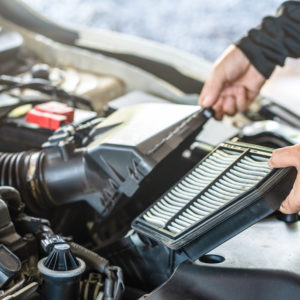Your vehicle’s intake system is crucial to the operation of your vehicle. It plays a vital role in pulling in oxygen, which is essential for combustion. You can consider buying an aftermarket cold air intake to enhance the system’s performance.
What Is a Cold Air Intake?
The engine needs three important things to function: compression, an air-fuel mixture, and spark. The intake system sends air to the engine through the intake manifold. The oxygen mixes with the fuel from the gas tank, and this air/fuel mixture is ignited inside the engine cylinders.
The cold air intake pulls cool air into the engine and combustion chamber. Cold air has more oxygen density than hot air. So it helps produce a more efficient combustion reaction, which boosts engine power and performance.
The Parts of a Typical Air Intake System

To help you get a better understanding of your vehicle’s factory air intake system, here are its main parts and their functions:
Air Filter and Housing
The air filter filters dirt and other debris from the air to prevent dirt and contaminants from entering the engine. It helps keep the oxygen in the intake system pure, which improves the engine’s performance.
The air filter resides in a housing, which is typically made of plastic. Fresh air gets pulled into the housing through an air inlet.
Mass Air Flow Sensor
The mass air flow sensor monitors the amount of air that enters the engine. Your vehicle’s computer needs this data to create the right air-fuel balance for an internal combustion reaction.
It’s important to point out that not all vehicles have a mass air flow sensor. Some instead use what’s referred to as a speed density fuel system in which the computer calculates the engine’s fuel needs based on a variety of sensors, including the manifold absolute pressure sensor, throttle position sensor, etc.
Resonator
Most air intake systems also have a resonator that reduces the turbulence of the air traveling through the air intake system. The primary purpose of the resonator is to reduce the noise created by the air intake system.
Air Intake Ducting
Ducting connects the various parts of the air intake system together by linking the air intake housing to the throttle body.
Throttle Body
The throttle body controls the flow of air into the engine’s intake manifold, and it plays a crucial role in controlling combustion rate and vehicle speed.
When the accelerator pedal is pressed, the throttle plate in the throttle body opens, allowing air into the engine. When the accelerator is released, the plate closes, which stops airflow from getting into the combustion chamber.
Do Cold Air Intakes Make a Difference?

Now that you have an idea about how complicated and important the intake system is, you may ask this question. Are cold air intakes worth it?
A cold air intake system replaces your vehicle’s factory air filter housing and ductwork with tubing and an open air filter element. Here are some of the benefits of a cold air intake:
Increased Horsepower
Cold air intakes increase horsepower, which is one of the reasons why many of their manufacturers include HP in their product highlights. However, some say how much power your gain greatly depends on your vehicle.
What’s definite is the fact that cold air intakes can bring cooler air into your engine, resulting in more efficient fuel burning.
Better Mileage
The intake system helps your ride reach the right air-to-fuel ratio. This means that if your vehicle has an adequate amount of oxygen, it can provide better mileage—which is exactly what cold air intakes do. After all, the engine will burn more fuel if it lacks or has insufficient oxygen.
Improved Acceleration
You might notice an improvement in your vehicle’s responsiveness when you install a cold air intake. That’s because air intake efficiency lets you reach your desired speed faster.

Drawbacks
Like some vehicle enhancements, upgrading your intake system can come with disadvantages. Here are some of them:
Potential Engine Performance Problems
Some cold air intake systems—particularly those that are low quality or don’t have ports for the factory intake air sensor—can cause engine performance problems, such as rough running and an illuminated check engine light.
Possibility of Voiding Your Car’s Warranty
If your car has a factory or extended warranty, adding a cold air intake may void that warranty. You’ll want to check with your provider prior to installation.
The Verdict
At the end of the day, it’s up to you to decide which enhancement is best for your engine.
If you’re planning on upgrading your intake system, make sure to source your components from legitimate sources like CarParts.com. Our site has a plethora of cold air intakes, so you’ll surely find a cold air intake that’s compatible with your ride.
Any information provided on this Website is for informational purposes only and is not intended to replace consultation with a professional mechanic. The accuracy and timeliness of the information may change from the time of publication.





























